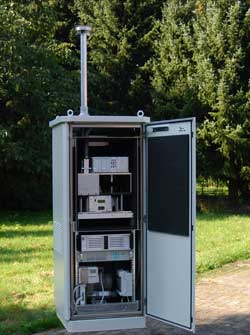Automatic measuring stations for pollen

“And here is the pollen forecast for tomorrow: Low levels of alder and hazel…” – we are all familiar with such reports from the radio and the television, but they are not always very reliable.
The forecast is based on the weather and the amount of pollen currently in the air. The problem is that few data on current pollen levels are available, as it is difficult and time-consuming to obtain them. Ambient air flows onto a piece of adhesive tape, and the pollen sticks there.
Laboratory workers examine the trapped pollen under a light-optical microscope and count the quantities of different grains. This is a tedious procedure and is only carried out at selected locations. A truly reliable forecast would require a closer-knit network of measuring stations.
The German weather service has therefore ordered 15 measuring stations: Researchers at the Fraunhofer Institute for Applied Information Technology FIT and for Toxicology and Experimental Medicine ITEM have developed these in collaboration with scientists working for Helmut Hund GmbH. The innovative feature is the analysis method: The stations determine the pollen composition fully automatically and transmit the data to the weather service. “To do this the stations, which are housed in a large container, ingest a controlled amount of air. The pollen grains contained in this air are cleansed of any impurities and deposited on a carrier,” says Prof. Dr. Thomas Berlage, director of Life Science Informatics at FIT.
The object carrier, a thin sheet of glass, is covered with a layer of gel. The pollen grains sink into this gel. A light-optical microscope automatically takes pictures of the pollen. However, there is a difficulty: In these two-dimensional images, the primarily spherical pollen grains – regardless whether they come from birch, hazel or alder trees – are only displayed as circles. When viewed in three dimensions, however, the different types of pollen exhibit differences such as furrows. “To overcome this difficulty, the microscope examines 70 different layers by automatically readjusting the focus 70 times,” explains Berlage. In some views the highest point of a pollen is in focus, in others the center. For each level, the system calculates the points that are most clearly pictured.
It then combines all these points to form a two-dimensional image that contains the three-dimensional information – the image shows the “flattened” top half of the pollen. If a pollen grain has a furrow at this point, it can be seen on the image. From this information, the system calculates certain mathematical features, compares these with a database, and determines the type of pollen. The results are available within one or two hours and are transmitted to the weather service via a network connection.
Media Contact
More Information:
http://www.fit.fraunhofer.deAll latest news from the category: Health and Medicine
This subject area encompasses research and studies in the field of human medicine.
Among the wide-ranging list of topics covered here are anesthesiology, anatomy, surgery, human genetics, hygiene and environmental medicine, internal medicine, neurology, pharmacology, physiology, urology and dental medicine.
Newest articles

Bringing bio-inspired robots to life
Nebraska researcher Eric Markvicka gets NSF CAREER Award to pursue manufacture of novel materials for soft robotics and stretchable electronics. Engineers are increasingly eager to develop robots that mimic the…

Bella moths use poison to attract mates
Scientists are closer to finding out how. Pyrrolizidine alkaloids are as bitter and toxic as they are hard to pronounce. They’re produced by several different types of plants and are…

AI tool creates ‘synthetic’ images of cells
…for enhanced microscopy analysis. Observing individual cells through microscopes can reveal a range of important cell biological phenomena that frequently play a role in human diseases, but the process of…





















